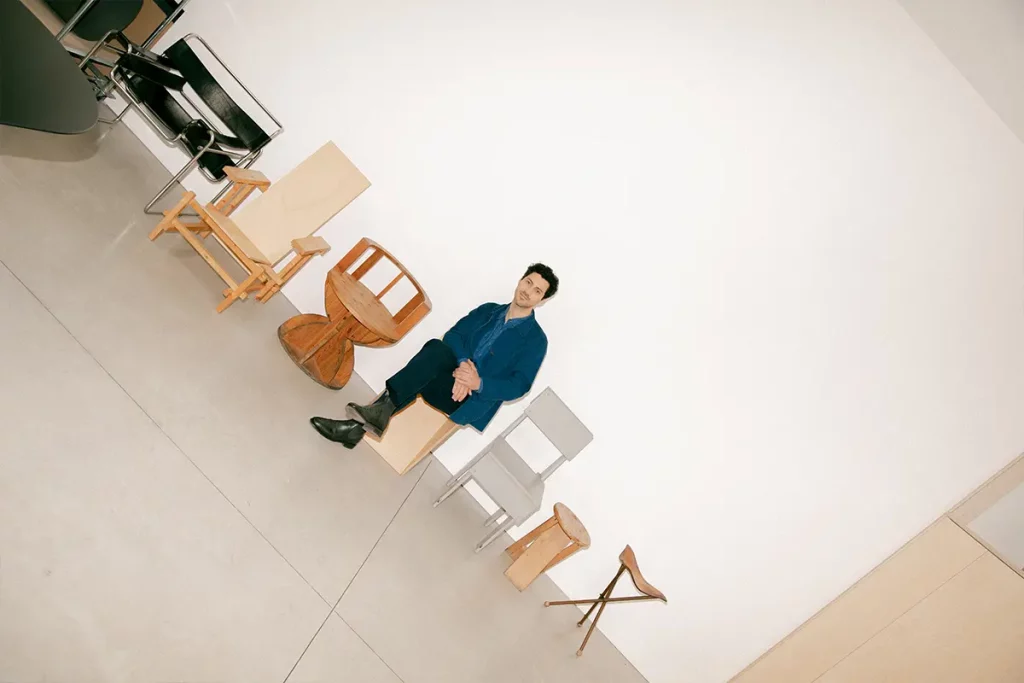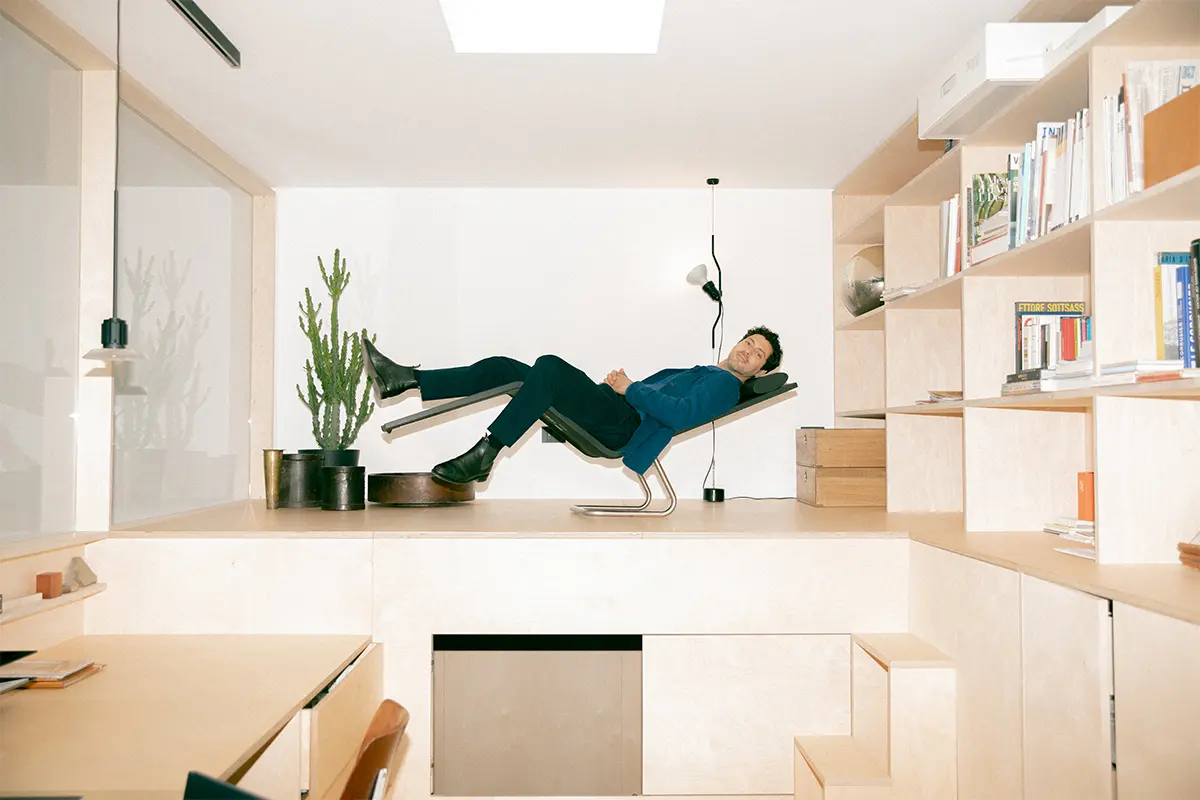Spring Studio introduces Guglielmo Poletti’s work. The designer aims to display style as a derivation of structure. Construction becomes a meaningful aesthetic
Lampoon, in collaboration with Spring Studio: Guglielmo Poletti, a work environment that conveys discussions
Somewhere in between instinctive design and interventive architecture, Guglielmo Poletti carries out limpid, raw structures mingling with furniture and lighting. One of his latest projects, To-Tie in collaboration with the Italian lighting company Flos further disclosed his identity on the design market. Guglielmo received recognition from magazines and studios prized by the EDIDA – ELLE DECO INTERNATIONAL DESIGN AWARDS while winning The best Cable Show for Wallpaper* Design Awards in 2023.
Living in Milan, he assembles not only design pieces but a work environment that can convey discussions and meetings, a shelter for opening up new conversations in the industry and how it can be playfully disrupted.
Boisbuchet and the Israeli designer Ron Gilad
Maria Hristina Agut
How did you come into design? What are some of your memories from when you first started on this path?
Guglielmo Poletti
I started getting closer to design twelve years ago, and it wasn’t a linear process. I got fascinated by design, slowly and in a very intuitive manner. One of my very first relevant experiences was a workshop I did at Boisbuchet in France in the summer of 2012 when I just started entering the world of design. Boisbuchat is a place that used and still organizes summer workshops with great personalities.
During that summer, I chose to work with Israeli designer Ron Gilad even though at that time I didn’t know anything about him or his designs which lead me to a week of experimentation. It allowed me to experience design through his gaze. There was a certain approach that was quite experimental, conceptual, and free, different from the industrial design. After that, I understood I had to go my way and find my path and that’s why I went to the Design Academy in Eindhoven in 2014, focusing on the two years of Master’s there and it became the starting point of my career.
Guglielmo Poletti’s criteria and work pillars
Maria Hristina Agut
What was the first project that allowed you to discover your identity on the market and your ‘style’?
Guglielmo Poletti
For many designers, style is a valuable term, but in my case, it’s not about style, it’s much more about a certain set of criteria that helped me find guidelines to deliver some meaning through work.
Maria Hristina Agut
Which are some of these criteria you use as pillars of your work?
Guglielmo Poletti
The criteria in my work are mainly focused on a strong interest in construction and structures. I’m a designer, but I work mainly with furniture and lighting design, and I’m very interested in architecture and its approach to the construction of an object; it interests me deeply. The starting point is a structural gesture, later trying to come up with some layers of meaning, which can be functional or aesthetically meaningful but always subordinated to a non-arbitrary starting point related to construction.

The research process in Guglielmo Poletti’s work
Maria Hristina Agut
What was one project that shifted your perspective?
Guglielmo Poletti
During the Master course in Eindhoven, the first year was about forgetting the meaning of what you’re doing which is quite disruptive. It pushed me to simply create without asking why – a very different approach to the one we are used to in the education system in Italy. Through this method, you are not envisioning what the outcome might be, and by doing so, if you have a good level of intuition and a good level of analytical skills, you learn that along the process, you start seeing the outcome.
Maria Hristina Agut
What about your research process? What do you try to emphasize when you prepare the outlines of a design?
Guglielmo Poletti
I never do conscious research. I think I just entered the industry from the back door, and galleries allowed me to experiment and have a certain freedom in the beginning. However, my mindset it’s very close to the industry that comes with the standardization of an idea and the refinement that it implies. You need to leave space for intuition, and that can only happen by going to the workshop, which is a core part of my studio – work hands-on. The starting point is always abstract. To catch an idea you need to go primitive.
The choice of materials and the aesthetics shapes
Maria Hristina Agut
When it comes to the materials you choose to use, do you have any preferences?
Guglielmo Poletti
There is no limit to the materials as far as I can play with them. For example, my graduation work was assembled with old pieces I made by myself, and there was a wide range of materials like metal wood, urethane rubber which I cast in the mold, and acrylic glass. They responded to the same structural logic and criteria I was trying to apply.
Maria Hristina Agut
What makes your line of work recognizable, and how would you describe it?
Guglielmo Poletti
There is an aesthetic in my work and I think it’s partially related to my innate language and my aesthetic preferences. Often the work is very naked. Most of it is built around one very precise detail that represents its core and incorporates all the formal qualities of the work. Often what I try to achieve is the idea that the work is self-explanatory. What does it want to achieve functionality-wise, and as a consequence of structure, statically-wise, what is its presence in the space?
Poletti’s collaboration with Flos
Maria Hristina Agut
One of your latest projects with lighting company Flos was highly recognized. How did this collaboration start?
Guglielmo Poletti
I was approached by Flos without a specific brief since they perfectly understood my individual interest in design, what I was trying to pursue on my own with my independent research. Among the first proposals I made, there was also a rework of a previous work of mine that I thought could become a good suspension light. It didn’t instantly work out, but sometimes the result isn’t obvious, and you have to make a big detour to get to the final idea.
So I went back to that idea on my own and reworked it by putting together a basic prototype, which already incorporated the soul of the project and allowed us to understand the real potential of a work. In the case of To-Tie, it’s all about its construction which keeps together the three main elements: the glass, the bar and the cable. The bar which includes the light source also functions as a handle while the electrical cable becomes a joint. Light is pleasingly trapped in the glass cylinder, being refracted in it despite its transparency.
To -Tie keeps together the three main pieces, the glass in the bar and the cable. Only later you can understand that the bar can become a lighting element and the cable is the one that delivers the electricity. Light is pleasingly trapped in the ceiling although it’s transparent, being refracted in it. I imagined this kind of paradox, a gap between starting freely and then coming up with something rational, adding layers of meaning and depth to the project.
The Modular Office Unit
Maria Hristina Agut
You were also speaking about your interest in architecture. The Modular Office Unit is one of your works leaping towards this area. What was your experience with developing it?
Guglielmo Poletti
It is the first project that can be considered architectural. It is sort of in between architecture and furniture because it’s a self-supporting structure. Sometimes when architects create great architecture, often they leave the ‘box’ quite empty. There is a space between that phase and the interior decoration phase. I am interested in trying to fill that gap with some private commissions. The Modular Office Unit could be considered a complex example of this in between. There was the box that was finished, and I had to still construct something that was responding to my own needs in the space.

Dismantling and reusing: a nomadic flexibility
Maria Hristina Agut
After the last years of being ‘trapped’ in our homes, the relationship with space somehow shifted. How do you see design changing in these years?
Guglielmo Poletti
I have to say I’m slightly confused about this scenario, because a lot of things were predicted during the pandemic, and then later on, I didn’t see the tangible changes happening yet, from many perspectives including the way we exhibit our work. The way you build a stand and the way you dismantle or reuse it could be similar to the way you become more nomadic and flexible. This gap between working as an architect and designer could be applied according to some standardization following the idea that you can adapt to the space in a bespoke and modular manner. The platform is called modular because it is made according to specific modules that could be conceptually applied to any other space.
The Equilibrium Collection and Guglielmo Poletti’s upcoming projects
Maria Hristina Agut
Is there a piece from the ones you developed that you feel more attached to?
Guglielmo Poletti
The first pieces from my graduation, The Equilibrium Collection, from which a lot has evolved later on. They stay with me, specifically the equilibrium console which I think is a very mature work lacking arbitrary choices. So for me the less arbitrary the work is, the more there is a reason for it including the material, the thickness, the shape.
Maria Hristina Agut
Is there something you’re working on at the moment?
Guglielmo Poletti
Since I currently work by myself, as a conscious choice to stay in touch with the client and the project as much as I can, my resources are limited and I can develop just a few projects at the time. At the moment, I am still working on lighting, which is a very fascinating world. It’s a technologically advanced field with a lot of engineering behind the production, and I like the paradox defined by the great amount of initial freedom and the complex rationality required by the process that follows. However, I am now finally back to furniture as well, working on some new and exciting industrial collaborations which I hope I will be able to unveil next year.
Guglielmo Poletti
Guglielmo Poletti (1987) is a Milan-based Italian designer. His work stretches across a variety of fields ranging from spatial interventions to the design of furniture and lighting pieces, conceived either as limited edition series or produced in collaboration with the industry.
Editorial curated by Spring Studios for Lampoon
Photography Clara Borrelli
Production @Spring Studios
Creative Director Anouk Jans @Spring Studios
Sr Art Director Simone Lorusso @Spring Studios
Producer Carlotta Cannata @Spring Studios
Videomaker Andrea Dal Martello @Spring Studios
Styling Giulia Parenti
Grooming Francesca Rezzola



















